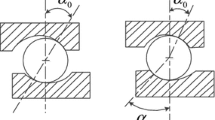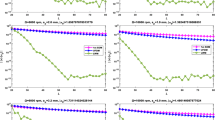Abstract
In this paper, stick–slip phenomenon of hydraulic forging press machine (HFPM), a nonlinear manufacturing system subjected to weak rigidity and negative friction velocity gradient, was investigated in slow-motion process. Dynamic characteristics of non-smooth motion were investigated experimentally under various operating conditions in slow-motion process. Taking into account the quadratic and cubic nonlinearities, the governing equation of the HFPM was derived. The method of multiple scales was employed to obtain approximate solution for velocity oscillation during slow motion. The steady-state responses for each case (i.e., non-resonance, primary, super-harmonic and sub-harmonic oscillation) were examined to investigate the correlation between velocity oscillation and nonlinear vibration in slow motion. The effects of viscous damping coefficient, hydraulic stiffness, friction parameters, excitation amplitude and frequency on the amplitude–frequency response characteristics were studied, and the interaction between system dynamics and tribological effects were presented. The stability of operational conditions and the critical velocity of the forging process were analyzed through the bifurcation techniques. Experimental results conducted on the HFPM verify the effectiveness of the proposed method.



















Similar content being viewed by others
References
Lu, X.J., Huang, M.H.: Multi-domain modeling based robust design for nonlinear manufacture system. Int. J. Mech. Sci. 75(10), 80–86 (2013)
Lu, X.J., Huang, M.H.: System decomposition based multi-level control for hydraulic press machine. IEEE Trans. Ind. Electron. 59(4), 1980–1987 (2012)
Rao, K.P., Prasad, Y.V.R.K., Suresh, K.: Materials modeling and simulation of isothermal forging of rolled AZ31B magnesium alloy: anisotropy of flow. Mater. Des. 32(5), 2545–2553 (2011)
Rowson, D.M.: An analysis of stick–slip motion. Wear 31(2), 213–218 (1975)
Korycki, J.: Mathematical model of the stick–slip phenomenon. Wear 55(2), 261–263 (1979)
Neis, P.D., De-Baets, P., Ost, W.: Investigation of the dynamic response in a dry friction process using a rotating stick–slip tester. Wear 271(9–10), 2640–2650 (2011)
Martins, J.A.C., Oden, J.T., Simoes, F.M.F.: A study of static and kinetic friction. Int. J. Eng. Sci. 28(1), 29–92 (1990)
Richard, T., Germay, C., Detournay, E.: A simplified model to explore the root cause of stick–slip vibrations in drilling systems with drag bits. J. Sound Vib. 305(3), 432–456 (2007)
Rabinowicz, E.: Friction and Wear of Materials. Wiley, New York (1965)
Teshima, T., Komura, Y.: Dynamical characteristics of the hydraulic feed system of machine tools: amplitude and period of stick–slip oscillation. Bull JSME. 21(153), 463–470 (1978)
Kang, J.: Parametric study on friction-induced coupled oscillator. Proc. Inst. Mech. Eng. Part C: J. Mech. Eng. Sci. 222(8), 1381–1387 (2008)
Ouyang, H., Mottershead, J.E., Cartmell, M.P.: Friction-induced parametric resonances in discs: effect of a negative friction–velocity relationship. J. Sound Vib. 209(2), 251–264 (1998)
Van-De-Velde, F., De-Baets, P.: A new approach of stick–slip based on quasi-harmonic tangential oscillations. Wear 216(1), 15–26 (1998)
Dankowicz, H., Nordmark, A.B.: On the origin and bifurcations of stick–slip oscillations. Phys. D. 136(3), 280–302 (2000)
Brian, A.H.: Stick slip and control in low-speed motion. IEEE Trans. Autom. Contr. 38(10), 1483–1496 (1993)
Velde, F.V.D., Baets, P.D.: Mathematical approach of the influencing factors on stick–slip induced by decelerative motion. Wear 201(1), 80–93 (1996)
Baets, P.D., Degrieck, J., Velde, F.V.D., Peteghem, A.P.V.: Experimental verification of the mechanisms causing stick–slip motion originating from relative deceleration. Wear 243(1), 48–59 (2000)
Thomsen, J.J., Fidlin, A.: Analytical approximations for stick–slip vibration amplitudes. Int. J. Non Linear Mech. 38(3), 389–403 (2003)
Pascal, M.: Dynamics of coupled oscillators excited by dry friction. J. Comput. Nonlinear Dyn. 3(3), 1–6 (2008)
Pascal, M.: New events in stick—slip oscillators behavior. J. Appl. Math. Mech. 75(3), 283–288 (2011)
Marin, F., Alhama, F., Moreno, J.A.: Modelling of stick–slip behaviour with different hypotheses on friction forces. Int. J. Eng. Sci. 60, 13–24 (2012)
Kato, S., Matsubayashi, T., Sato, N.: Some considerations on characteristics of static friction of machine tool slideway. J. Lubr. Technol. 94(3), 234–247 (1972)
Kato, S., Yamaguchi, K., Matsubayashi, T.: Stick–slip motion of machine tool slideway. J. Eng. Ind. Trans. ASME 96(2), 557–566 (1974)
Gao, C., Kuhlmann-Wilsdorf, D., Mekel, D.D.: Fundamentals of stick–slip. Wear 162(1), 1139–1149 (1993)
Gao, C., Kuhlmann-Wilsdorf, D., Mekel, D.D.: The dynamic analysis of stick–slip motion. Wear 173(1–2), 1–12 (1994)
Karnopp, D.: Computer simulation of stick–slip friction in mechanical dynamic systems. J. Dyn. Syst. Meas. Control 107(1), 100–103 (1985)
Chin, J.H., Chen, C.C.: A study of stick–slip motion and its influence on the cutting process. Int. J. Mech Sci. 35(5), 353–370 (1993)
Owen, W.S., Croft, E.A.: The reduction of stick–slip friction in hydraulic actuators. IEEE/ASME Trans. Mechatron. 8(3), 362–371 (2003)
Singh, B.R.: Study of critical velocity of stick–slip sliding. J. Eng. Ind. 82(4), 393–398 (1960)
Banerjee, A.K.: Influence of kinetic friction on the critical velocity of stick–slip motion. Wear 12(2), 107–116 (1968)
Li, C.B., Pavelescu, D.: The friction-speed relation and its influence on the critical velocity of stick–slip motion. Wear 82(3), 277–289 (1982)
Capone, G., Dagostino, V., Valle, S.D., Guida, D.: Stick–slip instability analysis. Meccanica 27(2), 111–118 (1992)
Fang, H., Xu, J.: Stick–slip effect in a vibration-driven system with dry friction: sliding bifurcations and optimization. J. Appl. Mech. 81(5), 1–10 (2014)
Ozaki, S., Hashiguchi, K.: Numerical analysis of stick–slip instability by a rate-dependent elastoplastic formulation for friction. Tribol. Int. 43(11), 2120–2133 (2010)
Yanada, H., Sekikawa, Y.: Modeling of dynamic behaviors of friction. Mechatronics 18(7), 330–339 (2008)
Xuan, B.T., Hafizah, N., Yanada, H.: Modeling of dynamic friction behaviors of hydraulic cylinders. Mechatronics 22(1), 65–75 (2012)
Marui, E., Endo, H., Hashimoto, M., Kato, S.: Some considerations of slideway friction characteristics by observing stick–slip vibration. Tribol. Int. 29(3), 251–262 (1996)
Muraki, M., Kinbara, E., Konishi, T.: A laboratory simulation for stick–slip phenomena on the hydraulic cylinder of a construction machine. Tribol. Int. 36(10), 739–744 (2003)
Powalka, B., Okulik, T.: Dynamics of the guideway system founded on casting compound. Int. J. Adv. Manuf. Technol. 59(1), 1–7 (2012)
Tarng, Y.S., Cheng, H.E.: An investigation of stick–slip friction on the contouring accuracy of CNC machine tools. Int. J. Mach. Tools Manuf. 35(4), 565–576 (1995)
Bilkay, O., Anlagan, O.: Computer simulation of stick–slip motion in machine tool slideways. Tribol. Int. 37(4), 347–351 (2004)
Wang, L.H., Wu, B., Du, R.S.: Nonlinear dynamic characteristics of moving hydraulic cylinder. Chin. J. Mech. Eng. 43(12), 12–19 (2007)
Chen, Y.S.: Nonlinear Vibrations. Higher Education Press, Beijing (2002)
Moradi, H., Vossoughi, G., Movahhedy, M.R., Ahmadian, M.T.: Forced vibration analysis of the milling process with structural nonlinearity, internal resonance, tool wear and process damping effects. Int. J. Non Linear Mech. 54(3), 22–34 (2013)
Sahebkar, S.M., Ghazavi, M.R., Khadem, S.E., Ghayesh, M.H.: Nonlinear vibration analysis of an axially moving drillstring system with time dependent axial load and axial velocity in inclined well. Mech. Mach. Theory 46(5), 743–760 (2011)
Moradi, H., Movahhedy, M.R., Vossoughi, G.: Dynamics of regenerative chatter and internal resonance in milling process with structural and cutting force nonlinearities. J. Sound Vib. 331(16), 3844–3865 (2012)
Acknowledgements
The authors would like to acknowledge the project supported by the Project of State Key Laboratory of High Performance Complex Manufacturing, Central South University, (Grant No. ZZYJKT2018-15), the Hunan Provincial Innovation Foundation for Postgraduate (Grant No. CX2013B062), the Innovation-driven Plan in Central South University (Grant No. 2015CX002), and the science and technology plan in Hunan Province (Grant No. 2016RS2015).
Author information
Authors and Affiliations
Corresponding author
Additional information
Publisher's Note
Springer Nature remains neutral with regard to jurisdictional claims in published maps and institutional affiliations.
Appendix: Derivations regarding stability of response behaviors for primary resonance
Appendix: Derivations regarding stability of response behaviors for primary resonance
Firstly, the steady-state solution for the primary resonance case is defined by \((a_0 ,\omega _0 )\); thus, the solution yields
In order to examine the stability of the steady-state response behaviors for the case of primary resonance, the small perturbations, denoted by \(\delta a\) and \(\delta \gamma \), are incorporated \(a = a_0 +\delta a\), \(\gamma _1 =\gamma _0 +\delta \gamma \), in Eqs. (37) and (38). Therefore, the linearized equations are expressed as
with the variables \(\sin \gamma _0 \) and \(\cos \gamma _0 \), obtained from Eqs. A.1 and A.2,
where
And the corresponding eigenvalue equation is defined by
where
The stability of steady-state solutions of primary resonance can be estimated based upon the sign of root of Eq. (A-7). Therefore, it can be deduced from Eq. (A-7) that the stability of the periodic solution for case I can be expressed by
In order to investigate the stability boundaries of corresponding response curves of primary resonance, differentiating Eqs. A.1 and A.2 to detuning parameter \(\sigma \) results in
By eliminating \({\hbox {d}\gamma }/{\hbox {d}\sigma }\), and substituting Eqs. A.5 and A.6 to A.14 and A.15, one derives
where
Let
Based on Eqs. A.13 and A.16, one can conclude that the boundary of stability of response curves is
Rights and permissions
About this article
Cite this article
Pan, Q., Li, Y., Huang, M. et al. Estimation of dynamic behaviors of hydraulic forging press machine in slow-motion manufacturing process. Nonlinear Dyn 96, 339–362 (2019). https://doi.org/10.1007/s11071-019-04793-1
Received:
Accepted:
Published:
Issue Date:
DOI: https://doi.org/10.1007/s11071-019-04793-1




